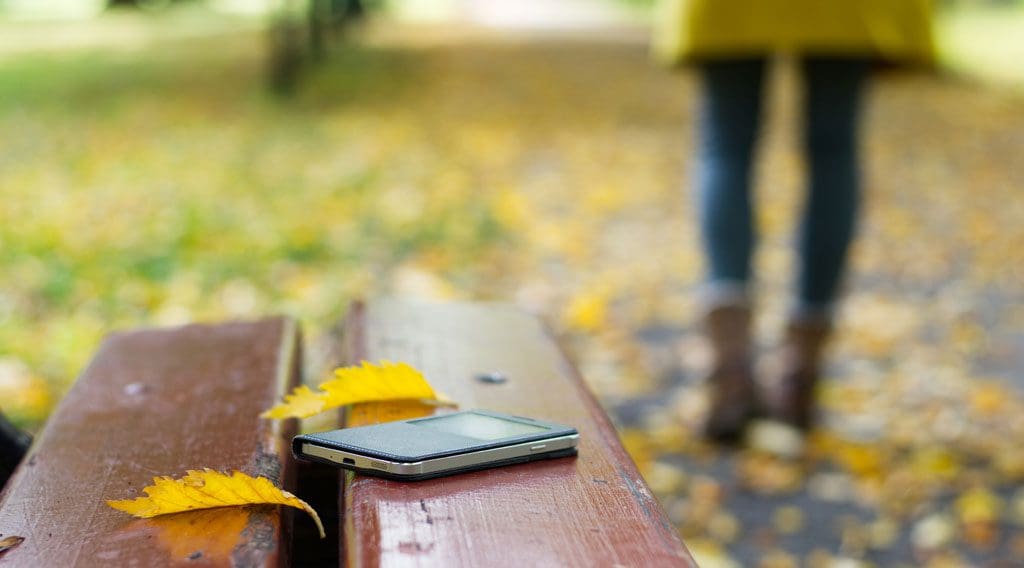I was driving to a meeting one morning when I realized I didn’t have my mobile phone. I automatically turned around to go back home even as my mind retraced my steps to find it. Was it at home or somewhere else? My anxiety levels increased as I imagined not finding my smartphone.
Where’s Siri when you need her?
I know I’m not alone in this.
Many people have become so dependent on our mobile phones to navigate and organize our daily lives. A study was conducted that showed 66% of smartphone users are genuinely afraid of either losing or being separated from their mobile phones.
There’s even a name for that phenomenon—Nomophobia (No Mobile Phone Phobia).
Our phones have become such an extension of our daily lives that losing a phone can feel like losing your most prized possession.
An ounce of prevention is worth a pound of cure.
We all know this wise advice to be true, from illness to problem-solving. So, here are some steps to take before you actually lose your phone:
1) Turn on Remote Tracking. Whether Android or iPhone, your smartphone will come with a built-in tool that lets you track it from the web or another device where you’re signed in with the same Google or Apple account, respectively. You can also use both Find My Device and Find My iPhone to remotely wipe your smartphone which can help protect your data especially if your phone was stolen.
On Androids, it’s called Find My Device, and you can enable it under Settings> Security & Location. On iPhones, it’s called Find My iPhone, and from Settings you need to tap your name, then your iPhone, to turn it on.
2) Protect the Lock Screen. Think about all the social media, shopping, email and banking apps you’re automatically signed into on your phone. The lock screen is your first line of defense between those accounts and anyone who picks up your phone. Make sure that you activate your screen protection, whether with a PIN, pattern, fingerprint, or your face. You can find these options under Security & Location in Android Settings, or Face ID & Passcode (or Touch ID & Passcode) in iPhone Settings.
For a greater chance of getting your phone back, leave a message on the lock screen with your email or an alternative phone number. For Android, go to Settings> Security & location> cog icon next to Screen lock> type Lock screen message. From the iPhone Health app, tap Medical ID to leave an emergency contact that’s accessible from the lock screen.
3) Back Up Your Data. Probably the biggest pain point in losing your phone is losing all your saved messages, important photos, account data and not knowing 90 percent of your stored phone numbers. You can write everything down on a piece of paper but (thankfully) your apps and your phone’s OS can take care of most of this for you by backing everything up. To backup system settings and app data, turn to your phone’s default backup system. On Android, go to Settings> System> Advanced> Backup. On iPhones, go to Settings> tap your name> your device> iCloud Backup (that is, if you’ve enabled iCloud on your device, which you should). Most apps automatically backup files in the cloud so you can start where you left off, but for photos and videos, apps like Dropbox or OneDrive can automatically upload these for you, or you can use the Google Photos or iCloud Photos options that come with your phone.
If you ever lose your phone.
Hundreds of people lose their phones every day, and it may happen to you sooner or later. Here are some things you can still do after it’s gone:
1) Call or Text Your Phone. Most of us ring our phone when we think we’ve misplaced it somewhere (a friend of mine found hers inside the refrigerator) and rightfully so, because once the battery is dead, it’ll be harder to find it or get a hold of the person who may have found it. If you actually lost your phone and the screen is locked, the person who found it might just be waiting for you to call.
2) Contact Your Carrier and the Police. The network operator can prevent someone else from running up a bill or impersonating you using your mobile number. They can also lock your SIM card and get you a replacement.
Reporting mobile theft with the local police might seem silly and farfetched, but what have you got to lose? Also, if you’ve taken out phone insurance, you’ll probably need a crime report reference, to make a claim so it’s another reason to register the theft.
3) Remotely Locate Your Device. If you turned on Remote Tracking, you can track down your missing device with another Android or iPhone, or you can go to the web and track it from there. You’ll also have the option to ring your smartphone, remotely lock the screen or remotely wipe the device.
4) Protect Your Accounts. If you lose your phone, it’s good to go online and log out of all your social media accounts, email accounts and to change your password for critical apps like shopping and online banking. It might also be beneficial to contact your bank or credit card company about potential theft from the loss of your phone.
5) Remotely Wipe all Data from Your Phone. If you’re absolutely sure that your phone is beyond recovery, do a remote wipe of the device and chalk it up to experience. Remember, this should be the last resort because it can’t be undone and a remote wipe will also kill any chance of remotely locating your lost mobile phone.
Have a tip to share? Let us know!
